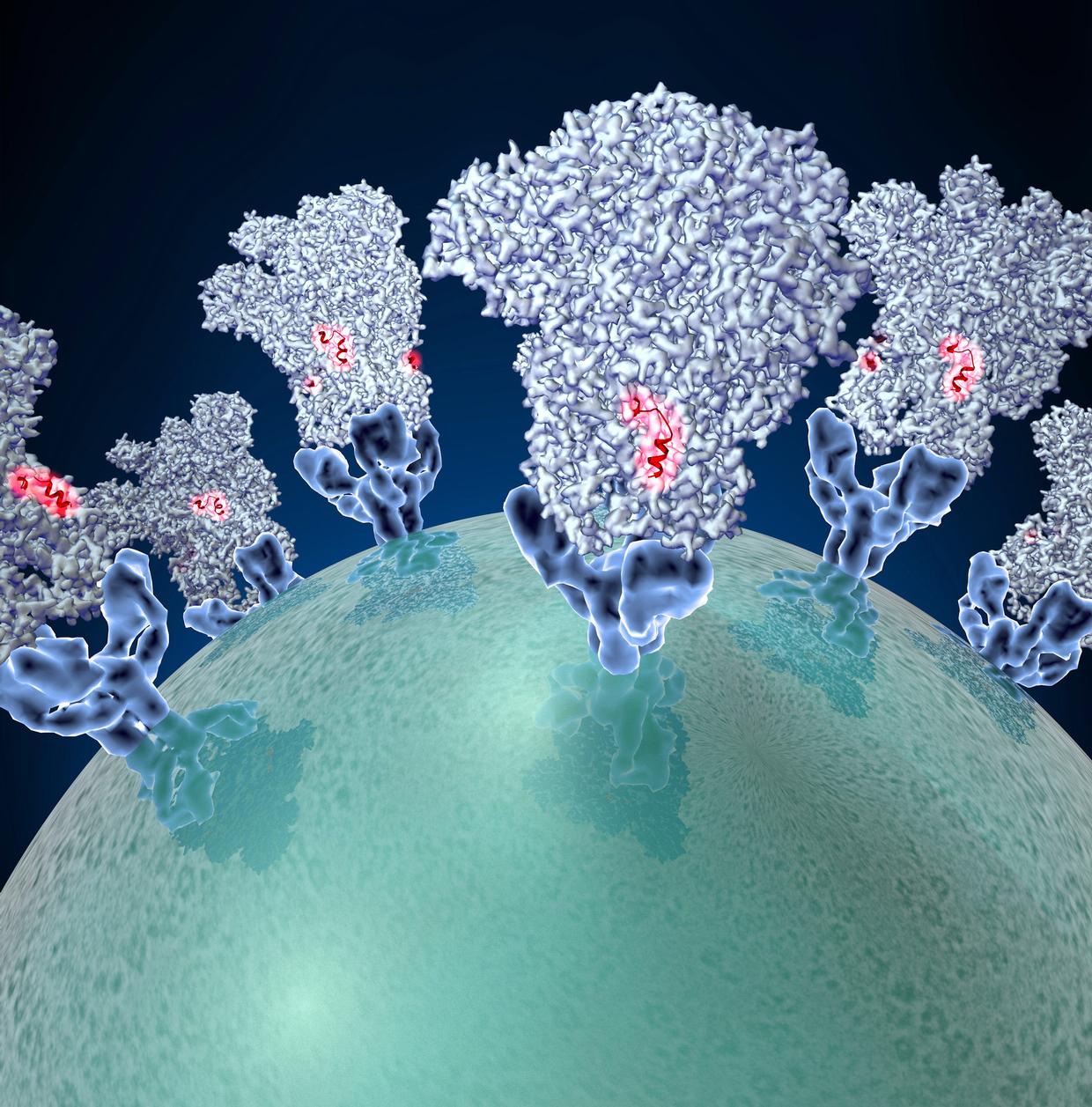New developments in producing a fentanyl vaccine could mean a preventative measure against opioid drug overdose.
By Jyoti Kinghorn
The National Institutes of Health reported over 100,000 drug overdose deaths in the US in 2021. A majority of these were due to fentanyl and other synthetic opioids. With the death toll from fentanyl overdoses sharply rising, scientists are working on a nontraditional solution—a fentanyl vaccine. Fentanyl vaccines use the body’s own immune system to render fentanyl ineffective after intentional or accidental drug use. A vaccine could not only treat but also prevent fentanyl addiction and overdose.
What is fentanyl?
Pharmaceutical-grade fentanyl is a synthetic opioid prescribed for extreme pain, such as that associated with terminal cancer. Fentanyl affects the brain in a similar way as other opioid drugs such as heroin, but it is more potent (about 100 times more than morphine and 50 times more than heroin, according to the CDC) and more addictive. Illegally made fentanyl is mixed with heroin, methamphetamine, MDMA, or cocaine to make them more powerful, more addictive, cheaper to produce, and significantly more deadly.
RELATED: Plant Combats Addictive Effects of Opioids
Fentanyl is also used to make counterfeit prescription drugs, which can be very difficult to visually differentiate from actual drugs (as shown in this video by the US Drug Enforcement Administration, or USDEA). Often, people obtaining drugs anywhere but a licensed pharmacist are not aware that they are taking fentanyl. But their chance of dying from a single fentanyl-laced pill is shockingly high. According to the USDEA, 6 out of 10 fake prescription pills laced with fentanyl now contain a lethal dose of fentanyl.
In 2021, the death toll in the US due to overdose by synthetic opioids including fentanyl was over 70,000. This number is sharply increasing every year as newer and deadlier formulations hit the streets.
How fentanyl works
Step 1: Crossing the blood-brain barrier. The brain is protected by a layer of tightly locked cells called the blood-brain barrier, which acts as a filter preventing molecules from freely entering or exiting the brain. The cells that make the blood-brain barrier are so tightly packed that it is difficult for large molecules to pass through. These cells are also lipid-based, so they repel water-soluble molecules. While the blood-brain barrier is great at keeping pathogens such as bacteria and viruses out of the brain, some types of small molecules such as alcohol and fentanyl pass right through. Once ingested or injected, fentanyl enters the blood, reaches the brain, and freely and rapidly crosses the blood-brain barrier to enter the brain.
Step 2: Interacting with the brain. The areas of the brain that control our perception of pain and emotions express opioid receptors, such as the mu-opioid receptor (MOR). The neurons in the brain synthesize peptides similar to opioids, which bind with MOR. By binding with these opioid-like peptides, MOR sends signals down the central nervous system that affect how the brain transmits the sensation of pain. MOR also modulates physiological functions such as respiration, stress, temperature, memory, mood, motivation, and even gastrointestinal and endocrine activities. Opioid drugs such as fentanyl mimic the peptides made by the brain and bind with MOR.
RELATED: Neuromodulation: How We Manipulate Brain Cells
When fentanyl binds with MOR, it affects the brain in a way that increases pain tolerance, sedation, addiction, and drowsiness, and elicits feelings of euphoria and confusion. Fentanyl also causes reduction in the amount of oxygen getting in the brain (hypoxia). When someone is having an overdose, hypoxia causes unconsciousness, coma, and death.
Currently available fentanyl therapies
One way to stop fentanyl from working is to have something else already occupying the brain’s MOR receptors. The FDA has approved several treatments, all of which target the MOR receptors in different ways. These include methadone, buprenorphine, naltrexone, and naloxone.
Methadone attaches to the receptors and activates them—albeit more stably and safely than opioid drugs—and eases withdrawal symptoms. Buprenorphine attaches to the receptors and partially activates them to also ease withdrawal symptoms. Naltrexone binds to the receptors, does not activate them, and prevents fentanyl from attaching to them. Naloxone binds to the MOR receptors more strongly than fentanyl, and can push out already bound fentanyl from the MOR receptors. Due to its efficacy, naloxone has been approved by the CDC for reversing the effects of an overdose.
RELATED: Can a Placebo Help Treat Opioid Use Disorder?
Problems with current fentanyl therapies
While life-saving, the current treatments have weaknesses. Methadone and buprenorphine can cause dysphoria, possible abuse, or overdose. On the other hand, naloxone can only be administered after an overdose has happened. It has a short duration of activity inside the body, and may wear off even as fentanyl in the blood prevails. Naloxone is also ineffective towards reversing “wooden chest syndrome,” where the chest muscles of someone having an overdose stiffen to the point of rendering CPR useless.
Another important drawback is that these medications are not prophylactic. They cannot be administered in advance to thwart future addiction or overdose. There is a critical need for new therapies that not only treat but also protect against opioid addiction. One unconventional though promising approach comes in the form of anti-opioid vaccines that use the body’s own immune system to destroy fentanyl.
How do fentanyl vaccines work?
Our bodies regularly make antibodies against biological pathogens such as bacteria and viruses. A small synthetic molecule like fentanyl would not typically instigate an immune response. However, the immune system can be trained to recognize fentanyl as a pathogen. This is done by attaching the fentanyl-based small molecule (called a hapten) to a larger biological molecule (called an immunogenic carrier). This immunogenic carrier is harmless but it is recognized by the immune system as a pathogen, which instigates a full-blown immune response. In animal systems, Crouse’s team showed that vaccination with a fentanyl hapten attached to an immunogenic carrier gets the body’s immune system to generate antibodies against fentanyl. These antibodies then mark fentanyl for destruction using the body’s immune machinery.
Depending on the vaccine’s efficacy and how strong an immune response it generates, it could be used to mop off fentanyl from the blood stream so none of it or not enough of it passes through the blood-brain barrier.
Considerations for anti-opioid vaccines
In their paper published in EMBO Reports, scientists Margaret Olson and Kim Janda named four fundamental components to consider for opioid vaccines.
(1) The antibodies should be specific to the drug. A vaccine against fentanyl should not destroy other drugs in the body. Most vaccines being developed today take this into consideration. For example, fentanyl-specific antibodies from the upcoming fentanyl vaccine do not recognize or in any way react to the four MOR-binding drugs most commonly used: methadone, buprenorphine, naltrexone, and naloxone. Therefore, being vaccinated would not harm a person’s chance to use medications for overdose reversal, etc.
(2) The vaccine should be made to address the drug’s active metabolic form. Once in the body, drugs can get metabolized and be broken into components, or their chemical structure can change significantly. The downstream products have their own effects on the brain. Olson and Janda provide the example of heroin. The form of heroin that is taken is not the primary psychoactive form. After being taken, heroin is quickly metabolized into morphine and 6‐acetylmorphine (6‐AM). 6-AM causes most of the psychoactivity associated with heroin. A hapten that is not based on the structure of 6-AM will not make an effective vaccine. However, with advances in our understanding of the structure and metabolism of various opioid drugs, most researchers choose excellent haptens for vaccine synthesis.
(3) The vaccine should generate sufficient antibodies. The immune response should be high enough to effectively counter and neutralize the drug in the bloodstream and destroy it before it reaches the brain.
(4) The vaccine should be effective at higher drug doses. The immune response should be robust enough to provide protection against overdose.
The results from anti-drug vaccines from the past indicate that points (3) and (4) are the hardest to optimize and standardize. Every person reacts to vaccines differently, but seeing low immune response in too many people getting the vaccine reduces a vaccine’s large-scale adoptability. This has been seen before. In Phase III clinical trials for vaccines against nicotine and cocaine, only those individuals who had a high immune response to the vaccine were able to notice a significant reduction in drug intake.
How to increase a vaccine’s immune response
To increase the immunogenicity of vaccines, one commonly added component is called an adjuvant. These are chemicals such as aluminum that are used in vaccine formulation that greatly increase the immune response generated as a result of the vaccination. Currently, a lot of improvement is being made to fentanyl vaccines by experimenting with different adjuvants.
Bethany Crouse at the University of Minnesota teamed up with researchers from multiple institutions for further research. In their seminal research published in npj Vaccines earlier this year, Crouse’s team showed that fentanyl vaccines with alum-adsorbed TLR7/8 adjuvants elicited a strong immune response in rats and pigs that provided significantly higher protection against hypoxia after fentanyl challenge. If the vaccine has such a good response in humans as well, it could be a great tool for combating addiction and overdose. The vaccine is headed towards Phase I clinical trials in 2024.
Clinical trials are underway
With the promise of safe, strong, and long-lasting immunity against deadly drugs, and demonstrated safety and efficacy in animal systems, anti-drug antibodies are going forward to clinical trials. In addition to the fentanyl vaccine discussed above, researchers from the University of Montana directed by Dr. Jay Evans are also advancing heroin vaccines for clinical trials in 2024. An anti-oxycodone vaccine developed by Dr. Sandra Comer’s group is currently in Phase Ia/Ib clinical trial (NCT04458545).
This study was published in the journal npj Vaccines, a Nature publication.
The information contained in this article is for educational and informational purposes only and is not intended as health or medical advice. Always consult a physician or other qualified health provider regarding any questions you may have about a medical condition or health objectives.
References
Centers for Disease Control and Prevention. (2023, August 8). Fentanyl. https://www.cdc.gov/opioids/basics/fentanyl.html
Centers for Disease Control and Prevention. (2023, September 6). Fentanyl Facts. https://www.cdc.gov/stopoverdose/fentanyl/index.html
Cleveland Clinic. (2023, April 17). Blood-Brain Barrier. https://my.clevelandclinic.org/health/body/24931-blood-brain-barrier-bbb
Crouse, B., Miller, S. M., Muelken, P., … & Pravetoni, M. (2023). A TLR7/8 agonist increases efficacy of anti-fentanyl vaccines in rodent and porcine models. npj Vaccines, 8, 107. https://doi.org/10.1038/s41541-023-00697-9
Hatsukami, D. K., Jorenby, D. E., Gonzales, D., … & Rennard, S. I. (2011). Immunogenicity and smoking-cessation outcomes for a novel nicotine immunotherapeutic. Clinical Pharmacology & Therapeutics, 89(3), 392–399. https://doi.org/10.1038/clpt.2010.317
Herman, T. F., Cascella, M., & Muzio, M. R. (2023). Mu Receptors. In StatPearls [Internet]. StatPearls Publishing. https://www.ncbi.nlm.nih.gov/books/NBK551554/
Kiyatkin, E. A. (2019). Respiratory depression and brain hypoxia induced by opioid drugs: Morphine, oxycodone, heroin, and fentanyl. Neuropharmacology, 151, 219–226. https://doi.org/10.1016/j.neuropharm.2019.02.008
Martell, B.A., Orson, F. M., Poling, J., … & Kosten, T. R. (2009). Cocaine vaccine for the treatment of cocaine dependence in methadone-maintained patients: a randomized, double-blind, placebo-controlled efficacy trial. Archives of General Psychiatry, 66(10), 1116–1123. https://doi.org/10.1001/archgenpsychiatry.2009.128
National Institute on Drug Abuse. (2021, June). Fentanyl DrugFacts. https://nida.nih.gov/publications/drugfacts/fentanyl
Olson, M. E., & Janda, K. D. (2018). Vaccines to combat the opioid crisis: Vaccines that prevent opioids and other substances of abuse from entering the brain could effectively treat addiction and abuse. EMBO Reports, 19, 5–9. https://doi.org/10.15252/embr.201745322
Researchers prep fentanyl, heroin vaccines for human trials. (2023, August 29). EurekAlert! https://www.eurekalert.org/news-releases/1000008
United States Drug Enforcement Administration. Public safety alert. DEA laboratory testing reveals that 6 out of 10 fentanyl-laced fake prescription pills now contain a potentially lethal dose of fentanyl. https://www.dea.gov/alert/dea-laboratory-testing-reveals-6-out-10-fentanyl-laced-fake-prescription-pills-now-contain
Valentino, R. J., Volkow, N. D. (2018). Untangling the complexity of opioid receptor function. Neuropsychopharmacology 43, 2514–2520. https://doi.org/10.1038/s41386-018-0225-3
Vo, Q. N., Mahinthichaichan, P., Shen, J., & Ellis, C. R. (2021). How μ-opioid receptor recognizes fentanyl. Nature Communications, 12, 984. https://doi.org/10.1038/s41467-021-21262-9

About the Author
Jyoti Kinghorn is a science writer based out of Austin, Texas. Trained in plant molecular biology, her freelance writing career in COVID times has taken her into the realm of human biotechnology and disease. She loves writing, reading, and being outdoors with her children.




